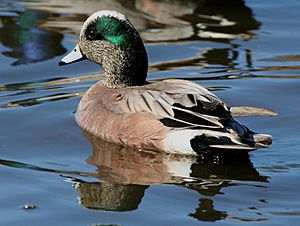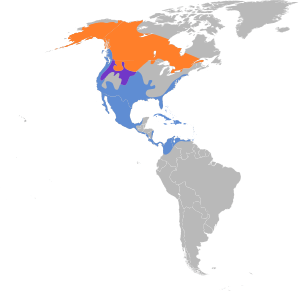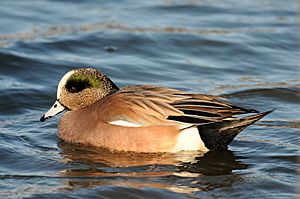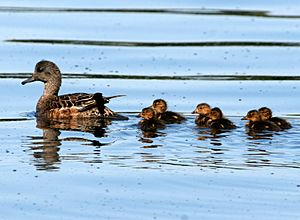American wigeon facts for kids
Quick facts for kids American wigeon |
|
|---|---|
 |
|
| Male | |
 |
|
| Female | |
| Conservation status | |
| Scientific classification | |
| Genus: |
Mareca
|
| Species: |
americana
|
 |
|
| Synonyms | |
|
Anas americana Gmelin, 1789 |
|
The American wigeon (Mareca americana), also known as a baldpate, is a type of dabbling duck found in North America. Dabbling ducks feed by tipping their bodies forward in the water, rather than diving completely under. This bird is related to other wigeons and is similar to the Eurasian wigeon found in other parts of the world. The name Mareca comes from a Brazilian-Portuguese word for a small duck, and americana means it's from America.
Contents
What Does the American Wigeon Look Like?

The American wigeon is a medium-sized duck. It's bigger than a teal but smaller than a pintail. You can often spot it by its round head, short neck, and small bill. These ducks are about 42 to 59 centimeters (16.5 to 23 inches) long. Their wingspan is about 76 to 91 centimeters (30 to 36 inches), and they weigh between 512 and 1330 grams (1.1 to 2.9 pounds).
Male Wigeons
The male wigeon, called a drake, is quite striking. It has a mask of green feathers around its eyes. A cream-colored patch runs from the top of its head to its bill. This white patch is why it's also called a "baldpate" (pate is an old word for head). Their belly is also white. When flying, male wigeons have a large white patch on each wing, which helps identify them. When not breeding, the male's feathers (plumage) look more like the female's.
Female Wigeons
Female wigeons, called hens, are less colorful. Their feathers are mostly gray and brown. Both male and female wigeons have a pale blue bill with a black tip. They also have a white belly and gray legs and feet. The wing patch behind the speculum (a patch of bright feathers on the wing) is gray. Female wigeons can be told apart from most ducks by their shape. They lay 6 to 12 creamy white eggs on the ground, usually near water and hidden by plants.
Sounds They Make
American wigeons are noisy birds. You can often identify them by their calls. Male wigeons make a three-note whistle that sounds like "whoee-whoe-whoe." Female wigeons make low, hoarse grunts and quacks, like "qua-ack."
Where Do American Wigeons Live?
American wigeons are common and found across a wide area. They breed in most parts of Canada and Alaska. They also breed in the western United States, including states like Idaho, Colorado, the Dakotas, and Minnesota. Their conservation status is "Least Concern," meaning they are not currently at risk of disappearing. Most of these ducks breed in the wetlands of the Boreal Forest and river deltas in Canada and Alaska.
Migration
These ducks are migratory. This means they fly south for the winter. They spend winter in the southern half of the United States, and even further south in Central America, the Caribbean, and northwestern South America. Sometimes, they are seen in western Europe, like Great Britain and Ireland, but this is rare.
How Do American Wigeons Behave?
The American wigeon likes open wetlands, such as wet grasslands or marshes with some tall plants. They mostly eat plants. They feed by dabbling, which means they tip their bodies into the water to reach plants. They also graze on land, eating grains from harvested fields, grasses, and other plants. Because they eat mostly plants, many wigeons migrate south before northern marshes freeze.
"Poacher" Ducks
Wigeons often gather with other water birds like American coots. They are known to grab pieces of plants that other diving birds bring to the surface. Because of this, they are sometimes called "poacher" or "robber" ducks!
Social Birds
Outside of the breeding season, American wigeons are very social. They often form large flocks with many other wigeons.
Images for kids
-
Male in flight at the Llano Seco Unit of the Sacramento National Wildlife Refuge Complex, California
See also
 In Spanish: Silbón americano para niños
In Spanish: Silbón americano para niños




